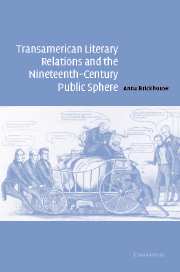Book contents
- Frontmatter
- Contents
- Acknowledgments
- Note on texts and translations
- Prologue
- 1 Introduction: transamerican renaissance
- 2 Scattered traditions: the transamerican genealogies of Jicoténcal
- 3 A francophone view of comparative American literature: Revue des Colonies and the translations of abolition
- 4 Cuban stories
- 5 Hawthorne's Mexican genealogies
- 6 Transamerican theatre: Pierre Faubert and L'Oncle Tom
- Epilogue
- Notes
- Index
Epilogue
Published online by Cambridge University Press: 22 September 2009
- Frontmatter
- Contents
- Acknowledgments
- Note on texts and translations
- Prologue
- 1 Introduction: transamerican renaissance
- 2 Scattered traditions: the transamerican genealogies of Jicoténcal
- 3 A francophone view of comparative American literature: Revue des Colonies and the translations of abolition
- 4 Cuban stories
- 5 Hawthorne's Mexican genealogies
- 6 Transamerican theatre: Pierre Faubert and L'Oncle Tom
- Epilogue
- Notes
- Index
Summary
“Our whole Caribbean elsewhere”: Julia Alvarez and transamerican renaissance at the millennium
In 1856, the same year in which Faubert warned his Haitian readership against the republic to the north, the future national poet of the Dominican Republic, Salomé Ureña, was six years old and remembering the song she used to sing with her sister, Ramona:
I was born Spanish,
By the afternoon I was French,
At night I was African.
What will become of me?
This childhood memory opens the first-person narrative strand of Julia Alvarez's In the Name of Salomé (2000), a novel that interweaves Ureña's literary and familial biography with a third-person account of her daughter's life as she carries Ureña's poetry and letters from the United States to Cuba, before returning to Dominican Republic to die. The song lyrics recalled by the six-year-old Salomé introduce the novel's central concern with poetry and memory, and, in particular, with the living texts that Salomé's future daughter, Camila Henríquez Ureña, will draw upon for sustenance in the physical absence of her mother, who dies when Camila is only three. But the lyrics also encapsulate the historically shifting national and racial identities of the Dominican Republic, formally separated in 1844 from Haiti, with which it shares the island of Hispaniola.
First settled by the Spanish as Santo Domingo, the eastern portion of Hispaniola had an early history quite different from that of its western counterpart in the French colony of Saint-Domingue, destined to become, as Haiti, the second independent nation in the American hemisphere.
- Type
- Chapter
- Information
- Publisher: Cambridge University PressPrint publication year: 2004

